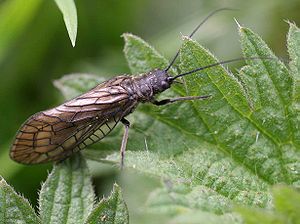Mudflies (family)
| Mud flies | ||||||||||
|---|---|---|---|---|---|---|---|---|---|---|

Common waterfly ( Sialis lutaria ) |
||||||||||
| Systematics | ||||||||||
|
||||||||||
| Scientific name | ||||||||||
| Sialidae | ||||||||||
| Leach , 1815 |
The mud flies or water flora flies (Sialidae) are a family of the large winged (Megaloptera). They are distributed worldwide with about 60 species. The Holarctic is their main distribution area. Their larvae are often found in large numbers and are therefore an important food for fish.
features
The animals have a relatively small and plump build with forewing lengths of 10 to 20 millimeters, while the females are usually larger than the males. They are predominantly brown in color and have no point eyes ( ocelli ). Your pronotum is relatively wide and also less long than it is wide. Their legs are strongly built and have five tarsal links . The fourth link is lobed and widened. Like the other large-winged birds, they have a strongly protruding wing veining on their large wings, which in the rest position are placed like a roof over the body.
The larvae have seven pairs of characteristic, feathery gills and a long, pointed end of the abdomen on the abdomen. They have large mandibles .
Way of life
The adults are diurnal and only fly sluggishly. You can find them in Central Europe from May to June on the bank vegetation, but they only live briefly.
The females lay up to 2000 eggs in groups of around 200 on the bank vegetation of various types of water. The larvae that hatch from it drop into the water. They initially live in the water, later buried in the mud. They occur up to a depth of 18 meters. They predatorily feed on insect larvae, worms and small clams. They usually need two years for their development, hibernate both times as larvae and go through 10 larval stages. They pupate underground on the bank. The pupa burrows to the surface before the imago hatches.
Systematics (Europe)
The mud flies occur in Europe with only 10 species of the genus Sialis .
The fossil species Sialis groehni and Sialis (Protosialis) baltica are also described from Baltic amber ( Eocene ) . These are the oldest fossil finds of this family to date.
Individual evidence
literature
- Ekkehard Wachmann, Christoph Saure: Netzflügler, Mud and Camel Neck Flies , Naturbuch-Verlag, Augsburg 1997, ISBN 3-89440-222-9
- Wilfried Wichard: Mud flies made from Baltic amber (Megaloptera, Sialidae) . In Mitt. Geol.-Paläont. Inst. Univ. Hamburg. 80 : 197-211, 2 illustrations, 9th plate, Hamburg 1997.
Web links
- Ord.Megaloptera mud flies ( Memento from May 11, 2008 in the Internet Archive )
